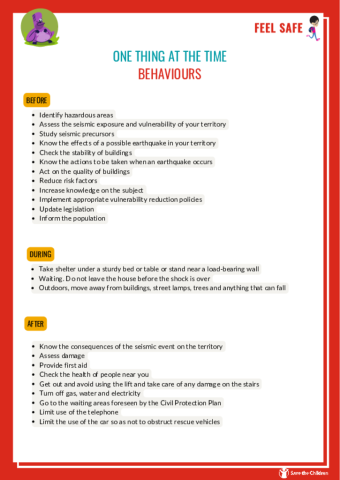One thing at the time
Objectives:
- Become familiar with key concepts related to the disaster management cycle
- Be better prepared to deal with earthquake emergencies
- Know the correct behaviour to adopt in an emergency
STEP BY STEP
BEFORE STARTING
The teacher introduces the activity by emphasizing the importance of knowing what actions to take and what to avoid during an earthquake to prevent and mitigate damage. The teacher explains that the activity will focus on three phases: before, during, and after an earthquake.
MATCHING PHASES
The teacher prepares sheets of paper or post-it notes, writing down behaviours related to each earthquake Sudden ground shaking resulting from movements of the earth’s crust phase. Depending on the number of teams, behaviours for each phase are assigned different colored post-it notes (e.g., yellow for one team, green for another).
To aid in this, the teacher can refer to the suggested behaviours (see attached "One Thing at a Time - Behaviours" below) for actions related to each phase. Three posters labeled BEFORE, DURING, and AFTER are placed around the classroom.
In teams, students receive an equal number of post-its in their assigned colors. Like a relay race, team members race to stick their post-its under the correct phase. To increase the challenge, some misleading or incorrect actions can be included. The team that correctly matches the most actions within the time limit set by the teacher (e.g., 5 minutes) wins.
The teacher writes down on different sheets of paper/post it the behaviours associated with the different phases of the earthquake. Depending on the number of teams planned, each behaviour in each phase should be written on different coloured post-it notes (e.g. if two teams are planned, all the behaviours of the three phases will be written on yellow and green post-it notes).
The teacher can use the attachment "One thing at the time - Behaviours" (below) to see some possible actions to be associated with the different phases.
The class then attach 3 posters with the words: BEFORE - DURING - AFTER in 3 different locations inside the classroom.
Divided into teams, they distribute the same number of post-its, using the same-coloured post-its for each of the groups. Like a relay race, the members of each group must stick the post-its under the corresponding phase. To make the challenge more complicated and exciting, misleading elements or incorrect actions can also be included. The winner is the one who associates the most actions with the correct phase in the time set by the teacher (e.g. 5 minutes).
THE PHASES OF THE EMERGENCY
The teacher writes the following terms on three separate boards and asks the class to discuss how each term relates to its phase:
- PREVENTION/PREPARATION
- EMERGENCY MANAGEMENT
- RECOVERY phase in the risk management cycle that involves the removal of all possible obstacles to facilitate the resumption of normal living conditions
PARTICIPATORY CONSTRUCTION OF DEFINITIONS
The class engages in a brainstorming session to define the following terms, possibly referring to a glossary for assistance:
- PREVENTION
- PREPARATION
- EMERGENCY MANAGEMENT
- RECOVERY phase in the risk management cycle that involves the removal of all possible obstacles to facilitate the resumption of normal living conditions
CONCLUDING THOUGHTS
Reflecting on the behaviors identified, the class discusses what actions each individual can implement independently, which ones require adult assistance, and those that necessitate the involvement of technicians and experts.

Add new comment